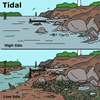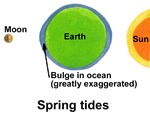 The Moon and the tides
The Moon and the tides
The daily changes in water levels of the oceans are called tides. In general
terms, the difference in gravitational forces acting on different sides
of the Earth due to the Moon and to a lesser extent, the Sun is the chief
cause of tides - or bulges in a body's surface. Tides occur on both the
Earth and the Moon. On the Moon there is no water, so the effect is on
the solid surface of the Moon. This same effect happens on Earth, but
is not noticed against the much larger rise and fall of the oceans.
With the daily rotation of the Earth, the tidal water bulges cross the planet twice a day. As a tidal water bulge (predominantly created by the gravitational attraction of the Moon) reaches a coastline, it causes a high tide on the coast. Low tide is a quarter turn away on the Earth's surface.

|
Tides |
Frequency of the tides
 There are three factors which affect the frequency of high and low tides:
the orbit of the Moon around the Earth once every 29 1/2 days, the rotation
of the Earth each 24 hours and the two tidal bulges on opposite sides
of the Earth. One bulge is on the side of the Earth closest to the Moon
and the second bulge is on the opposite side of the Earth, furthest from
the Moon. The animation shows the effect of the orbit of the Moon on the
movement of the tidal bulges around the Earth each month and the effect
of the Earth's rotation creating two high tides and two low tides each
rotation.
There are three factors which affect the frequency of high and low tides:
the orbit of the Moon around the Earth once every 29 1/2 days, the rotation
of the Earth each 24 hours and the two tidal bulges on opposite sides
of the Earth. One bulge is on the side of the Earth closest to the Moon
and the second bulge is on the opposite side of the Earth, furthest from
the Moon. The animation shows the effect of the orbit of the Moon on the
movement of the tidal bulges around the Earth each month and the effect
of the Earth's rotation creating two high tides and two low tides each
rotation.
The tidal ebb - water moving out from a coast causing a falling tide - and flow - water moving in to a coast causing a rising tide - occurs twice a day on average. The actual time between two high or low tides is 12 hours and 25 minutes. The extra 25 minutes is due to the combined effects of the orbit of the Moon and the rotation of the Earth. While the Earth rotates once in 24 hours and Moon has moved on 1/29 of its orbit, thus to get back to the same position relative to the Moon, the Earth must rotate for another 50 minutes. In this time, two bulges pass around the Earth, so two high tides and two low tides occur in this time.
The second tidal bulge
The cause of the second bulge on the opposite side of the Earth to the
Moon, is generally not well understood. The second bulge is due to the
lack of gravitational attraction by the Moon on the waters on the far
side of the Earth. The solid Earth is closer to the Moon than the water
on the far side of the Earth and is thus attracted more strongly towards
the Moon than the water on the far side of the Earth. This difference
in attraction between the solid Earth and the water shows up as the second
bulge as the water gets left behind!
 The Sun and the tides
The Sun and the tides
The Sun has a smaller tidal effect on the Earth, adding and subtracting
its effect to that of the Moon on our oceans. When the Moon and Sun are
in line with the Earth, "Spring Tides" occur which are correspondingly
higher and lower than average. When the Moon and Sun are at right angles,
the rise and fall of the tides is less than average causing "Neap
Tides".

|
Spring/Neap tide |
The differences in tidal heights around the world are due to the interference with the movement of tidal ebb and flow by the continents, bays and ocean currents. In the Bay of Fundy, Canada, tide differences as high as 21 metres have been recorded! In northern Western Australia near Broome pretty big tides occur as well. Some places like the Gulf of Mexico in the U.S.A. only have one high and low tide each day. The real story is much more complicated than this simple model indicates, but it is a good start. See the Web Sites for more information.
| Copyright owned by the State of Victoria (Department of Education and Early Childhood Development). Used with Permission. |
|
|||||||||||||||||||||||